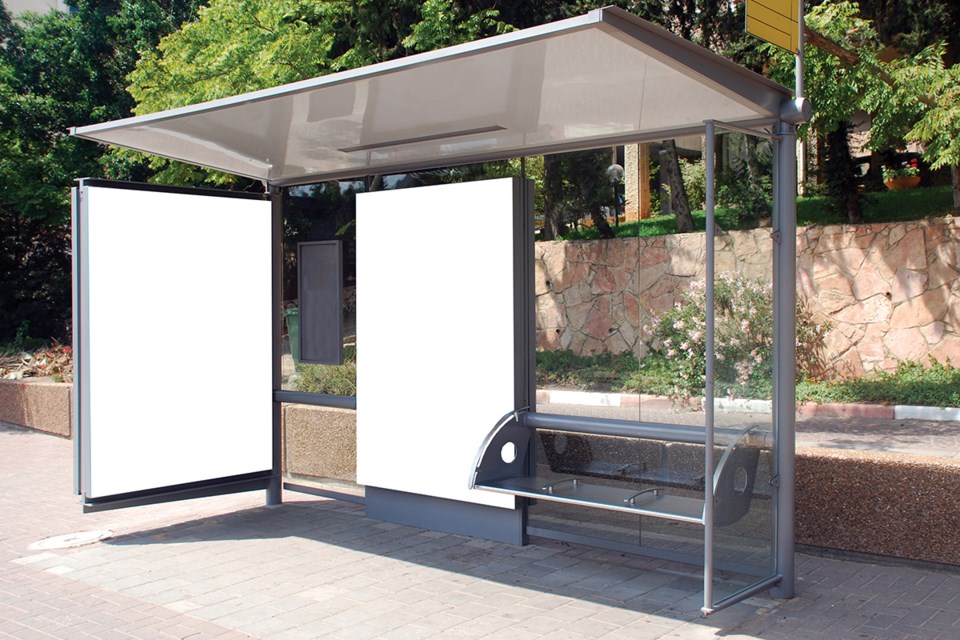Bus shelters coming
Fifteen bus shelters with advertising on them are on their way to Squamish streets. Council provided input for an Advertising Bus Shelters Goods and Services Agreement at its committee of the whole on Tuesday afternoon.
The shelters will include a seating bench, lighting – operated by solar panels – and will be outfitted with a framed poster board, according to the proposal. They will be placed at various locations throughout the district.
The Squamish proponents, Bill Fredericks and Martin Sprenkels, first proposed the idea to council back in April of 2015 as a revenue sharing venture.
Staff was directed to finalize the proposal on April 21, 2015. The final agreement will be for 10 years. All capital costs will be funded by the proponents. The district will be responsible for site preparations, bear-safe garbage bins and garbage collection, according to the agreement.
In addition to these shelters, the district currently has eight bus shelters installed and four in the budget for this year.
New Edo on the way
Squamish will soon have an economic development officer.
At committee of the whole Tuesday, mayor and councillors recommended the adoption of its new Economic Development Review and Action Plan.
The committee decided an in-house development officer would work best at implementing the plan, rather than an arms length person or board.
One of the highlights of the plan, which is described as a guide for future decision-making, includes developing an incubator for existing businesses and/or an accelerator for start-up businesses.
The plan also includes developing a gateway into Squamish and a downtown community plaza.
“This is a living document,” said Mayor Patricia Heintzman. “This is a first step.”
Producing the strategic document cost the district $35,000. The plan will go before a future council for ratification. An economic development officer will be hired thereafter, according to district staff.
Repeal tax exemption?
It comes down to a debate around what is fair.
Council voted last week to start the process of repealing the Oceanfront Revitalization Tax Exemption bylaw. In simple terms, the bylaw, which was part of the deal to sell the oceanfront lands to Newport Beach Developments, meant businesses that set up on the oceanfront would get a break from municipal taxes.
The objective of the exemption was to encourage growth on the lands.
The revitalization tax was to last from Jan. 1, 2016 to Aug. 31, 2025, according to district documents.
Downtown and business park revitalization tax exemptions have recently expired. Coun. Doug Race was absent from the committee meeting in July when council members voted to start the process and he objects to the plan.
“It was a constant item in our negotiations,” said Race. “The ink is barely dry on the cheque and now we are going to pull that. That to me seems wrong.” Race said if parts of deals are pulled, people will think council can’t be trusted. Coun. Jason Blackman-Wulff said the developer of the oceanfront has come back for changes since the deal as well. He said the original idea was to have parity between the downtown and the Oceanfront.
“If a development is not viable because there is no more tax exemption then they need to revise their business plan,” he said. Mayor Heintzman said the process is just starting and the issues raised can be debated in the process. The issue will be back before a future council meeting.
Expansion deferred
The landfill expansion versus sending waste out of town to a transfer station debate was brought back up at the committee of the whole Tuesday.
Council deferred a decision on vertical expansion of the landfill after Coun. Jason Blackman-Wulff raised the issue of a transfer station as a more affordable option. Council was set to direct staff to prepare an agreement for consultants to design the vertical expansion of the landfill after the committee meeting, but will now go back to the drawing board and bring back transfer station options and information when the Zero Waste strategy comes before council in October.
In the spring, council voted to pursue vertical expansion as opposed to a transfer station.
The issue is that the landfill is reaching capacity much faster than expected.
Overall, vertical expansion would incur capital costs of about $5 million.
If the committee had been in agreement, construction on vertical expansion was anticipated to begin in January, according to district staff.



